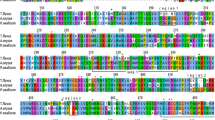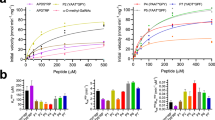Abstract
The interactions between TCS and AMP, ADO, TUB., CMP were studied by crystallographic method, which confirmed that TCS specially recognizes ADE, but does not recognize cytosine. When TCS interacts with mononucletide, the ligand with or without phosphate is not important. The proton H+ of guanidinum group of Arg163 is shared by N3 of ADE, but is not received by N7. This enriches the model of N-glycosidase mechanism about TCS and AMP. This model should suit to the interaction between RIPs and AMP, and reflect the main interaction between RIPs and rRNA. However, the interaction between RIPs and rRNA is more complicated. To comprehensively understand recognition and catalysis of RIPs against rRNA, at least the RIP/RNA segment complex crystal structure should be determined. This RNA segment should contain stem and loop with GAGA sequence.
Similar content being viewed by others
References
Zhang Xuejun, Wang Jiahuai, Homology of trichosanthin and ricin A chain,Nature, 1986, 321 (6069): 477.
Zhang Jinsong, Liu Wangyi, The mechanism of action of trichosanthin on eukaryotic ribosome-RNA N-glycosidase activity of the cytotoxin,Nucleic Acids Research, 1992, 20(6): 1271.
Gao Ben, Ma Xingqi, Wang Yaoping et al., Refined structure of Trichosanthin at 1.3 Å resolution,Science in China (in Chinese), Ser.B, 1993, 23(3):272.
Wong, K. B., Ke, Y. B., Dong, Y. C. et al., Structure/function relationship study of Gln156, Glu160 and Glu189 in the active site of trichosanthin,Eur. J. Biochem., 1994, 221:787.
Dong Yicheng, Wong, R. N. S., Shao Pangchui et al., The model of substrate interaction with trichosanthin by computer graphic simulation,Acta Biophysica Sinica (in Chinese), 1994, 10(1): 13.
Yang Jie, Wu Shen, Dong Yicheng, Crystal structure of complex of TCS with FMP,Acta Biophysica Sinica (in Chinese), 1994, 10(4):537.
Xiong Jianping, Xia Zongxiang, Wang Yu, Crystal structure of trichosanthin-NADPH complex at 1.7 Å resolution reveals active-site architecture,Nature Structural Biology, 1994, 1(10):694.
Ren Jingshan, Wang Yaoping, Dong Yicheng et al., The N-glycosidase mechanism of ribosome-inactivation protein implied by crystal structures of α-momorcharin,Structure, 1994, 2(1):8.
Monzingo, A. F., Robertus, J. D., X-ray analysis of substrate analogs in the ricin A-chain active site,J. Mol. Biol., 1992, 227: 1136.
Huang Qichen, Liu Shenping, Tang Youqi et al., Studies on crystal structure, active-centre geometry and depurinating mechanism of two ribosome-inactivating protein,Biochem. J., 1995, 309:285.
Hu Hongyu, Lu Zixian, Study on trichosanthin hydrolyzing the N-glycoside bond of 5′-AMP by1H NMR method,Chinese Science Bulletin (in Chinese), 1994, 39(18):1720.
Chen Hong, Wang Yue, Yan Maogong et al., 5′-AMP phosphatase activity on trichosanthin and other single chain ribosome inactivating proteins,Chinese Biochemical Journal (in Chinese), 1996, 12(2): 125
Stroud, R. M., The crystal and molecular structure of tubercidin, C11H14N4O4,Acta Cryst., 1973, B29:690.
Author information
Authors and Affiliations
Additional information
Project supported by the National “863” Program.
Rights and permissions
About this article
Cite this article
Wu, S., Lu, X., Zhu, Y. et al. N-glycosidase mechanism of Trichosanthin. Sci. China Ser. C.-Life Sci. 41, 174–180 (1998). https://doi.org/10.1007/BF02882724
Received:
Issue Date:
DOI: https://doi.org/10.1007/BF02882724




